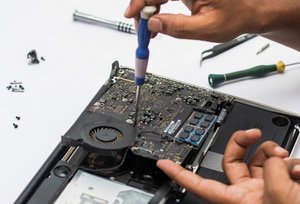I can tell you that you don't need a degree to learn how to do this. I repair anything that says apple on it at the component level. I've been doing it for about 12 years. I learned how to do it on my own. I did a lot of electronic work in the military but that was a whole different ball game. You should be familiar with basic circuits and how individual components actually work. Thats all I had going into the Apple side. It took a lot of trial and error to learn how apples work. But once I figured it out, it was all similar afterwards. Every apple product has a unique problem based on what the product is. Imac, Emac, iBook, MacBook, whatever. From what i've learned over the years, Apple doesn't do a whole lot of in depth testing on their products. Thats why they are always coming out with new stuff. The volume I did at one time ranked our service center top 5 in the world. By doing so many units, I saw the individual problems and actually was in direct contact with Apple to let them know if there was a similar failure on a specific model. When it got big enough, it was time for them to decide if they should do a recall or not. And anyone that knows Apple, will also know that for them to do a recall is pretty much non existent. What they do is called a "Repair Extension." They'll fix your unit up to 1 year after the warranty expires "IF" it exhibits the said problem.
So back on point, the main thing you need to do this is the tools. Figuring out the component problems is the easy part. Replacing, say a BGA chip, can't be done by hand. (look up BGA if you don't know what one is). We bought a 50 thousand dollar machine that replaces these chips for you. Oh, I tried every way to Sunday to do it by hand, and actually fixed a few, but the ratio was so bad that we had to get the machine if we wanted to do this and make money at it.
The easiest way to figure it out, is to assign "Zones" to a logic board. Video area, drive controller area, memory area, etc. Then when you have a video problem, you look in the video zone. The comment about reverse engineering above is exactly the way to figure out what the "good" part is suppose to be doing. Many times you can visually see the bad part under magnification. Other times you cant. Then you just have to start troubleshooting the components in the effected zone. Doesn't take that long once you get the hang of it, but it's not something your going to learn how to do in a few months. It takes years to perfect it. My suggestion to anyone that wants to get into repairing component level, send it out for repair instead. It will save you a lot of time and money. Just make sure you use a reputable company.
Hope this shed some light on the questions.
crwdns2934105:0crwdne2934105:0
crwdns2934113:0crwdne2934113:0
crwdns2915270:0crwdne2915270:0
crwdns2889612:0crwdne2889612:0
24


 213
213  159
159  63
63 











crwdns2944067:04crwdne2944067:0
Good Question++ Electronics Engineering is your best bet, but brace yourself!!!!
crwdns2934271:0crwdnd2934271:0 Majesty crwdne2934271:0
I'm going to see if I can find a "dummies guide". Obviously an engineering degree would be awesome, but this is a very specific goal, and I bet the basics of MacBook logic board repair can be learned in a week with the right resources.
crwdns2934271:0crwdnd2934271:0 rdklinc crwdne2934271:0
Hi All! Thanks for the suggestions. Over the last year I've definitely come across some interesting techniques (check out some of the recent MacBook unibody repair discussions at rdklinc.com/answers) but I think the best one so far is to take out the logic board, and scrub it down thoroughly with 90% rubbing alcohol and a soft toothbrush. Not very scientific, but it often works. :-)
crwdns2934271:0crwdnd2934271:0 rdklinc crwdne2934271:0
Watch Louis Rossmann on Youtube as he has many repair videos that actually explain how to diagnose problems with Macbook logic boards at the component level https://www.youtube.com/channel/UCl2mFZo...
crwdns2934271:0crwdnd2934271:0 Peter Newman crwdne2934271:0